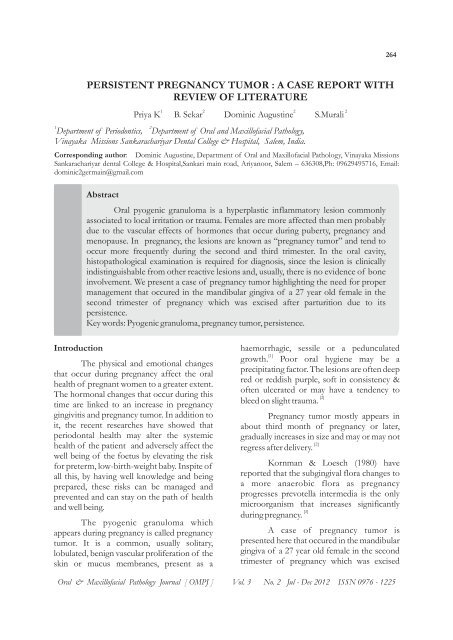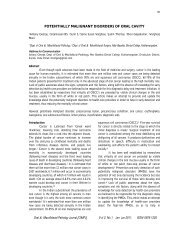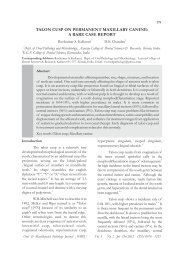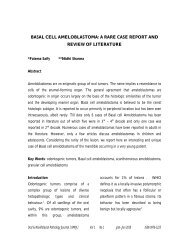persistent pregnancy tumor : a case report with review of ... - A4add
persistent pregnancy tumor : a case report with review of ... - A4add
persistent pregnancy tumor : a case report with review of ... - A4add
Create successful ePaper yourself
Turn your PDF publications into a flip-book with our unique Google optimized e-Paper software.
264<br />
PERSISTENT PREGNANCY TUMOR : A CASE REPORT WITH<br />
REVIEW OF LITERATURE<br />
1 2 2 2<br />
Priya K B. Sekar Dominic Augustine S.Murali<br />
1 2<br />
Department <strong>of</strong> Periodontics, Department <strong>of</strong> Oral and Maxill<strong>of</strong>acial Pathology,<br />
Vinayaka Missions Sankarachariyar Dental College & Hospital, Salem, India.<br />
Corresponding author: Dominic Augustine, Department <strong>of</strong> Oral and Maxill<strong>of</strong>acial Pathology, Vinayaka Missions<br />
Sankarachariyar dental College & Hospital,Sankari main road, Ariyanoor, Salem – 636308,Ph: 09629495716, Email:<br />
dominic2germain@gmail.com<br />
Abstract<br />
Oral pyogenic granuloma is a hyperplastic inflammatory lesion commonly<br />
associated to local irritation or trauma. Females are more affected than men probably<br />
due to the vascular effects <strong>of</strong> hormones that occur during puberty, <strong>pregnancy</strong> and<br />
menopause. In <strong>pregnancy</strong>, the lesions are known as “<strong>pregnancy</strong> <strong>tumor</strong>” and tend to<br />
occur more frequently during the second and third trimester. In the oral cavity,<br />
histopathological examination is required for diagnosis, since the lesion is clinically<br />
indistinguishable from other reactive lesions and, usually, there is no evidence <strong>of</strong> bone<br />
involvement. We present a <strong>case</strong> <strong>of</strong> <strong>pregnancy</strong> <strong>tumor</strong> highlighting the need for proper<br />
management that occured in the mandibular gingiva <strong>of</strong> a 27 year old female in the<br />
second trimester <strong>of</strong> <strong>pregnancy</strong> which was excised after parturition due to its<br />
persistence.<br />
Key words: Pyogenic granuloma, <strong>pregnancy</strong> <strong>tumor</strong>, persistence.<br />
Introduction<br />
haemorrhagic, sessile or a pedunculated<br />
[1]<br />
The physical and emotional changes<br />
growth. Poor oral hygiene may be a<br />
that occur during <strong>pregnancy</strong> affect the oral<br />
precipitating factor. The lesions are <strong>of</strong>ten deep<br />
health <strong>of</strong> pregnant women to a greater extent.<br />
red or reddish purple, s<strong>of</strong>t in consistency &<br />
The hormonal changes that occur during this<br />
<strong>of</strong>ten ulcerated or may have a tendency to<br />
[2]<br />
time are linked to an increase in <strong>pregnancy</strong><br />
bleed on slight trauma.<br />
gingivitis and <strong>pregnancy</strong> <strong>tumor</strong>. In addition to<br />
Pregnancy <strong>tumor</strong> mostly appears in<br />
it, the recent researches have showed that about third month <strong>of</strong> <strong>pregnancy</strong> or later,<br />
periodontal health may alter the systemic gradually increases in size and may or may not<br />
health <strong>of</strong> the patient and adversely affect the regress after delivery. [2]<br />
well being <strong>of</strong> the foetus by elevating the risk<br />
for preterm, low-birth-weight baby. Inspite <strong>of</strong><br />
Kornman & Loesch (1980) have<br />
all this, by having well knowledge and being <strong>report</strong>ed that the subgingival flora changes to<br />
prepared, these risks can be managed and a more anaerobic flora as <strong>pregnancy</strong><br />
prevented and can stay on the path <strong>of</strong> health progresses prevotella intermedia is the only<br />
and well being. microorganism that increases significantly<br />
[3]<br />
during <strong>pregnancy</strong>.<br />
The pyogenic granuloma which<br />
appears during <strong>pregnancy</strong> is called <strong>pregnancy</strong><br />
A <strong>case</strong> <strong>of</strong> <strong>pregnancy</strong> <strong>tumor</strong> is<br />
<strong>tumor</strong>. It is a common, usually solitary, presented here that occured in the mandibular<br />
lobulated, benign vascular proliferation <strong>of</strong> the gingiva <strong>of</strong> a 27 year old female in the second<br />
skin or mucus membranes, present as a trimester <strong>of</strong> <strong>pregnancy</strong> which was excised<br />
Oral & Maxill<strong>of</strong>acial Pathology Journal [ OMPJ ] Vol. 3 No. 2 Jul - Dec 2012 ISSN 0976 - 1225
Persistent Pregnancy Tumor : A Case Report With Review Of Literature<br />
265<br />
after parturition due to its persistence swelling had not regressed and remained the<br />
highlighting the need for proper same<br />
management.<br />
After reduction in inflammation,<br />
Case Report<br />
lesion was excised along <strong>with</strong> raising <strong>of</strong><br />
periodontal flap in area <strong>of</strong> the mandibular<br />
A 27 year old female <strong>report</strong>ed to the<br />
incisors and open curettage <strong>of</strong> area was<br />
dental clinic <strong>with</strong> a chief complaint <strong>of</strong> a<br />
performed.[Fig2]<br />
swelling on the lower anterior jaw region for<br />
the past one week. There was no history <strong>of</strong><br />
Excised lesion was sent for<br />
pain associated <strong>with</strong> the lesion. There was histopathological examination, [Fig 3] which<br />
bleeding on brushing that was present since revealed epithelial proliferation and<br />
one month. There was no difficulty in speech underlying capillary proliferation [Fig 4] <strong>with</strong><br />
or mastication.<br />
engorged red blood cells [Fig 5] and<br />
endothelial cell proliferation along <strong>with</strong><br />
O n e x a m i n a t i o n a s i n g l e<br />
marked inflammatory cell infiltration seen in<br />
erythematous bright red, pedunculated<br />
connective tissue. [Fig 6]<br />
gingival growth, irregular in shape, measuring<br />
3 x 2.5 cms in size was present on the Early healing was uneventful as patient<br />
mandibular gingiva. [ Fig 1]<br />
<strong>report</strong>ed after one week for suture removal.<br />
Patient was reinstructed for maintenance <strong>of</strong><br />
It extended from the distal line angle<br />
oral hygiene. No recurrence has been observed<br />
<strong>of</strong> 42 to the mesial line angle <strong>of</strong> 31. It<br />
after 3 months <strong>of</strong> follow up.<br />
extended 1.5cms onto the attached gingiva.<br />
No calculus or food debris was present. Few Discussion<br />
areas <strong>of</strong> extrinsic stains were present.<br />
Pyogenic granuloma is a vascularized<br />
On palpation it was s<strong>of</strong>t in mass originally described in 1897 by Poncet &<br />
consistency, tender and bleeding on palpation Dor, who named this lesion “human<br />
<strong>with</strong>out ulceration was present. No lymph botryomycosis”.<br />
[4]<br />
The term “pyogenic<br />
nodes were palpable. There was no history <strong>of</strong> granuloma” was proposed by Hartzell (1904)<br />
drug intake and other significant medical although it is a misnomer since the condition<br />
history.<br />
is not associated <strong>with</strong> pus and does not<br />
It was found that the patient was in<br />
[5]<br />
represent a true granuloma.<br />
her second trimester <strong>of</strong> <strong>pregnancy</strong>.<br />
Patient was unable to maintain oral<br />
hygiene in this area, because <strong>of</strong> gingival<br />
enlargement, rest <strong>of</strong> the oral cavity showed<br />
normal gingiva and satisfactory oral hygiene.<br />
A provisional diagnosis <strong>of</strong> pyogenic<br />
granuloma was made. Differential diagnosis<br />
was peripheral giant cell granuloma.<br />
Considering her <strong>pregnancy</strong> no<br />
invasive surgical procedure was carried out.<br />
Oral prophylaxis was performed after routine<br />
haematological investigation. Instructions<br />
regarding maintenance <strong>of</strong> oral hygiene were<br />
given. She was advised to visit the department<br />
after parturition. Patient <strong>report</strong>ed one month<br />
after an uneventful first <strong>pregnancy</strong>. The<br />
Fig 1: A single erythematous bright red, pedunculated<br />
gingival growth, irregular in shape present on the<br />
mandibular gingiva.<br />
Oral & Maxill<strong>of</strong>acial Pathology Journal [ OMPJ ] Vol. 3 No. 2 Jul - Dec 2012 ISSN 0976 - 1225
Persistent Pregnancy Tumor : A Case Report With Review Of Literature<br />
266<br />
Fig 2: The lesion was excised along <strong>with</strong> raising <strong>of</strong><br />
periodontal flap in area <strong>of</strong> the mandibular incisors and open<br />
curettage <strong>of</strong> area was performed<br />
Fig 5: H&E stain, 10X view showing<br />
proliferation <strong>with</strong> engorged red blood cells<br />
capillary<br />
Fig 3: Excised lesion which was sent for histopathological<br />
examination.<br />
Fig 4: H&E stain, 10X view showing epithelial<br />
proliferation and underlying capillary proliferation.<br />
Fig 6: H&E stain, 10X view showing endothelial cell<br />
proliferation along <strong>with</strong> marked inflammatory cell<br />
infiltration seen in connective tissue<br />
Oral health care in <strong>pregnancy</strong> is <strong>of</strong>ten<br />
avoided and misunderstood by physicians,<br />
dentists, and patients. Evidence-based<br />
practice guidelines are still being developed. A<br />
recent international similar study carried out<br />
in USA by Silk H et al suggested that every<br />
pregnant woman should be screened for oral<br />
risks, counselled on proper oral hygiene, and<br />
referred for dental treatment when necessary.<br />
Appropriate dental care and prevention<br />
during <strong>pregnancy</strong> may reduce poor prenatal<br />
[6]<br />
outcomes.<br />
The lesion appears as a hyperplastic<br />
inflammatory response to local irritation or<br />
trauma. In the oral cavity, repeated gingival<br />
inflammation secondary to plaque, calculus<br />
and foreign body are sufficient to initiate<br />
lesion development. Females are more<br />
Oral & Maxill<strong>of</strong>acial Pathology Journal [ OMPJ ] Vol. 3 No. 2 Jul - Dec 2012 ISSN 0976 - 1225
Persistent Pregnancy Tumor : A Case Report With Review Of Literature<br />
267<br />
commonly affected probably due to the irritation favor leakage <strong>of</strong> fluid into<br />
vascular effects <strong>of</strong> hormones that occur perivascular tissues and results in increase in<br />
during puberty, <strong>pregnancy</strong> and menopause. In pocket depth and hence associated <strong>with</strong><br />
<strong>pregnancy</strong>, the lesions are known as transient tooth mobility. Destruction <strong>of</strong><br />
“<strong>pregnancy</strong> <strong>tumor</strong>” and tend to occur more gingival mast cells by the increased sex<br />
frequently during the second and third hormones and the resultant release <strong>of</strong><br />
trimester. The incidence <strong>of</strong> occurrence is histamine and proteolytic enzymes may also<br />
more common in maxilla than mandible. Our contribute to the exaggerated inflammatory<br />
<strong>case</strong> has occurred on the mandibular gingiva. response to local factors. O'Neil in 1979,<br />
It usually regresses after <strong>pregnancy</strong> but in our suggested that during <strong>pregnancy</strong>, a depression<br />
<strong>case</strong> persisted even after <strong>pregnancy</strong>.<br />
<strong>of</strong> the maternal t- lymphocyte response may<br />
be a factor in the altered tissue response to<br />
The term <strong>pregnancy</strong> <strong>tumor</strong> was first plaque. [9]<br />
coined by Blum in 1912. In 1946 Ziskin and<br />
In absence <strong>of</strong> significant esthetic or<br />
[7]<br />
Ness compiled a clinical classification <strong>of</strong> functional problems or both, the lesion<br />
<strong>pregnancy</strong> gingivitis as follows:<br />
should not be excised because it may resolve<br />
after parturition. Local irritants should be<br />
Class I – Characterized by bleeding gingiva removed. Those lesions failing to resolve<br />
<strong>with</strong> more or less, no other manifestations. should be surgically excised. Follow up <strong>of</strong> the<br />
Class II- Characterized by changes in the patient is needed because pyogenic granuloma<br />
interdental papilla-edema and swelling <strong>with</strong> exhibits a tendency to recur. [10]<br />
subsequent blunting <strong>of</strong> interdental papilla.<br />
Class III- Characterized by involvement <strong>of</strong> Conclusion<br />
the free gum margin, which takes on the color Solitary conditioned enlargements are among<br />
and general appearance <strong>of</strong> a raspberry.<br />
the most frequently encountered conditions<br />
Class IV– Generalized hypertrophic gingivitis by the clinician. These lesions present similar<br />
<strong>of</strong> <strong>pregnancy</strong>.<br />
clinical features <strong>with</strong> lot <strong>of</strong> variance in<br />
Class V – The <strong>pregnancy</strong> <strong>tumor</strong>. underlying etiologies. Surgical excision is the<br />
Pregnancy itself cannot cause<br />
preferred treatment <strong>of</strong> choice, <strong>with</strong> removal<br />
gingivitis, gingivitis in <strong>pregnancy</strong> is caused by<br />
<strong>of</strong> local irritants to prevent recurrence. For<br />
b a c t e r i a l p l a q u e p o s s i b l y t h a t<br />
<strong>pregnancy</strong> <strong>tumor</strong>, a conservative approach is<br />
recommended. Complete treatment can be<br />
bacterial–hormonal interactions may change<br />
provided after parturition. We have presented<br />
the composition <strong>of</strong> plaque and thereby lead to<br />
a <strong>case</strong> <strong>of</strong> <strong>pregnancy</strong> <strong>tumor</strong> in a 27 year old<br />
gingival inflammation.<br />
female which did not regress after parturition<br />
Kornman and Loesche in 1980 which was treated by surgical excision.<br />
<strong>report</strong>ed that the sub gingival flora changes to<br />
a more anaerobic flora as <strong>pregnancy</strong><br />
Acknowledgements<br />
progresses mainly Prevotella Intermedia will<br />
We would like to thank Dept. <strong>of</strong> Oral<br />
predominate. This increase appears to be Medicine & Radiology and Pr<strong>of</strong>. Dr.<br />
associated <strong>with</strong> elevations in systemic levels <strong>of</strong> Thiruneervannan (Principal, Vinayaka<br />
Estradiol and Progesterone, which can Missions Sankarachariyar Dental College) for<br />
substitute for Menadion (vitamin k) essential his guidance and encouragement.<br />
growth factor for Prevotella Intermedia and<br />
[8]<br />
coincide <strong>with</strong> gingival bleeding.<br />
References<br />
Increased levels <strong>of</strong> progesterone, 1. Elen de Souza Tolentin, Livia de Souza<br />
produce dilation and tortuosity <strong>of</strong> gingival Tolentino. Recurrent intraoral pyogenic<br />
microvasculature, circulatory stasis and granuloma: <strong>case</strong> <strong>report</strong>. Odontologia. Clin.<br />
increased susceptibility to mechanical Cientif, Recife. 8 (3): 263-267, 2009.<br />
Oral & Maxill<strong>of</strong>acial Pathology Journal [ OMPJ ] Vol. 3 No. 2 Jul - Dec 2012 ISSN 0976 - 1225
Persistent Pregnancy Tumor : A Case Report With Review Of Literature<br />
268<br />
Periodontol, 2000; 71: 1375-84.<br />
2. Brad W. Neville, Douglas D. Damm. S<strong>of</strong>t 7. Zarka FJ, Stark MM, gingival <strong>tumor</strong>s <strong>of</strong><br />
tissue <strong>tumor</strong>s. Oral and maxill<strong>of</strong>acial<br />
<strong>pregnancy</strong> <strong>review</strong> <strong>of</strong> <strong>pregnancy</strong> <strong>tumor</strong>s and a<br />
pathology. Second edition. 2002; 447-9.<br />
<strong>report</strong> <strong>of</strong> two <strong>case</strong>s, Obstetrics And Gynecology<br />
3. Kornman KS, Loesch WJ. The subgingival<br />
1956;8(5):595-600.<br />
microbial flora during <strong>pregnancy</strong>. J Perio dont 8. Newman MG, Takie HH, klokkevold PR,<br />
Res 1980;15:111.<br />
carranza's clinical periodontology 10th ed<br />
4. Poncet, A. & Dor, L. Botryomycose humaine.<br />
Saunders 2007, pg 536.<br />
Rev. Chir. 18:996, 1897.<br />
9. Sousa S, Coelho, Bretegant, Vieira, Olivera,<br />
5. Hartzell, M. B. Granuloma pyogenicum<br />
Clinical and Histological evaluation <strong>of</strong><br />
(botryomycosis <strong>of</strong> French authors). J. Cutan.<br />
Granuloma Gravidarium <strong>case</strong> <strong>report</strong>. Braz<br />
Dis, 22:520-3, 1904.<br />
Dent J. 2000; 11(2): 135-139.<br />
6. Lacopino AM, Cutler CW. Pathophysiological 10. Rose LF, Mealey BL, Genco RJ, Cohen DW,<br />
relationships between periodontitis and systemic<br />
Periodontics Medicine, Surgery, Oral<br />
disease: recent concepts involving serum lipids. J<br />
Implants selected s<strong>of</strong>t and hard tissue lesions<br />
<strong>with</strong> periodontal relevance 1st ed Mosby 2004<br />
Source <strong>of</strong> Support - Nil<br />
Conflict <strong>of</strong> Interest - None declared<br />
How to cite this article:<br />
Priya K, B. Sekar,Dominic Augustine, S. Murali: Persistent <strong>pregnancy</strong> <strong>tumor</strong> : a <strong>case</strong> <strong>report</strong> <strong>with</strong> <strong>review</strong> <strong>of</strong><br />
literature, Oral Max Path J, 3(2), Jul-Dec 2012: 264-268<br />
Oral & Maxill<strong>of</strong>acial Pathology Journal [ OMPJ ] Vol. 3 No. 2 Jul - Dec 2012 ISSN 0976 - 1225







